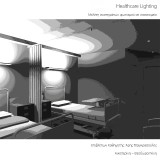The light, whether natural or artificial, has some characteristics and qualities that allow man to perceive the external world and receive stimuli through vision. Natural lighting is a fundamental element in the everyday life of man and the artificial one, on the other hand, thanks to technological advancement has helped to extend the day through the nightlife of human life.
In this specific research topic, artificial lighting systems in health care settings will be examined to see whether artificial illumination can affect the patient's psychology, accelerate recovery, and improve employee performance at the same time. Choosing space is not accidental as in a hospital, there are many difficulties that can be encountered in designing lighting systems, especially in places where many groups of people coexist, each with different needs.
Finally, a key element of this work is the measurements made in a double room in the pediatric clinic. In this way it was possible to compare the standard values (ANSI / IES RP-29-16) with the values found during the room metering. The final part of the work is the proposal to improve, to meet the needs of patients, nurses and relatives,dividing the space into three conceivable zones, so that the needs of the groups are served as the problem arises, the space is for two patients.
By combining all the information, namely the theoretical data, the measurement results, the standard values and the needs of the people, lighting fittings suitable for hospitals were selected and placed in several places in the hospital room, as the values from the photometry were quite low.
The final stage is the simulation of the lighting fixtures in the Relux program and the photorealistic images, which present in many phases, what will be the space with the new lighting systems.
